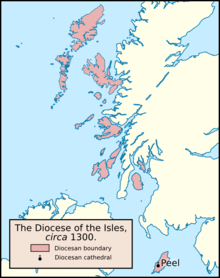Diocese of the Isles
Coordinates: 54°13′34″N 4°41′53″W / 54.22620°N 4.6981°W

The Diocese of the Isles, also known as the Diocese of Sodor, was one of the thirteen dioceses of medieval Scotland. The original seat of the bishopric appears to have been at Peel, on St Patrick's Isle, where indeed it continued to be under English overlordship; the Bishopric of the Isles as it was after the split was relocated to the north, firstly Snizort and then Iona.
The diocese in its full form included the Outer Hebrides, most of the Inner Hebrides (including Iona, Skye, Raasay, Canna, Eigg, Coll, Tiree, Mull, Colonsay, Islay, Jura, Gigha - but not Lismore, Kerrera, Seil or Luing, all under the Bishop of Argyll), the Isle of Bute and the Isle of Arran, as well as the Isle of Man (Mann). The diocese may have originally contained Galloway, a suggestion thought to explain the possible attacks of Wimund on Bishop Gilla Aldan of Whithorn.

The diocese was severed after the English acquisition of Mann in the 14th century. From the 11th century until the creation of the Archdiocese of Trondheim, Mann and the Isles appear to have been under the jurisdiction of the Archbishop of York. Thereafter until 1472, it was formally under Trondheim; but in that year, the Bishopric of St. Andrews was elevated to an archdiocese, and the Isles came under her jurisdiction.
The Bishopric's links with Rome ceased to exist after the Scottish Reformation, but continued, saving temporary abolition between 1638 and 1661, under the episcopal Church of Scotland until the Revolution of 1688. Episcopacy in the established church in Scotland was permanently abolished in 1689 but it continued in the now nonconformist Scottish Episcopal Church until 1702 with the death of Bishop Archibald Graham. The diocese then came under the care of the Bishop of Ross or Caithness or Moray variously. A new united Scottish Episcopal Diocese of Argyll and The Isles was established in 1847 with Bishop Alexander Ewing as the first Bishop living at Lochgilphead.
References
 This article incorporates text from a publication now in the public domain: Herbermann, Charles, ed. (1913). "Diocese of Argyll and the Isles". Catholic Encyclopedia. New York: Robert Appleton.
This article incorporates text from a publication now in the public domain: Herbermann, Charles, ed. (1913). "Diocese of Argyll and the Isles". Catholic Encyclopedia. New York: Robert Appleton. This article incorporates text from a publication now in the public domain: Herbermann, Charles, ed. (1913). "Ancient Diocese of Sodor and Man". Catholic Encyclopedia. New York: Robert Appleton.
This article incorporates text from a publication now in the public domain: Herbermann, Charles, ed. (1913). "Ancient Diocese of Sodor and Man". Catholic Encyclopedia. New York: Robert Appleton.- Dowden, John (1912), Thomson, J. Maitland, ed., The bishops of Scotland: being notes on the lives of all the bishops, under each of the sees, prior to the reformation, James Maclehose and sons.
See also
- Bishop of the Isles, list of bishops of the Isles
- Diocese of Sodor and Man